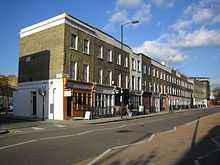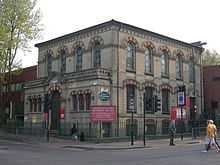Caledonian Road, London

The Caledonian Road runs about a mile and a half north-south through the London Borough of Islington. It connects North London, starting at Camden Road near the junction with Holloway Road, and central London's Pentonville Road in the south. It is often known colloquially as the "Cally" and forms the entirety of the A5203.
The street is mostly residential from Camden Road until Caledonian Road tube station. There are many new residential developments around the station including student accommodation. Just south of the station is Pentonville Prison near the bridge carrying the North London Line. South of here, the road is mostly lined by a wide variety of shops and cafes including several Ethiopian restaurants. This area is quite poor compared to the north end and the shops serve both the council estates bordering the road and the more affluent Barnsbury area adjacent to the east, mostly Georgian terraces. The road crosses Thornhill Bridge over the Regents Canal and south of here are more trendy shops and restaurants that have appeared in recent years because of the King's Cross Central developments. The road ends at Pentonville Road near King's Cross railway station and the border of Camden. Housmans Bookshop, specialist radical book and magazine retailers established in 1945, can be found here at No.5, as well as the offices of Peace News and the small anarchist organisation London Greenpeace, the people behind the McLibel Trial.
In August 2013, the railway bridge which runs over the Road was repainted to remove the word "Ferodo" (one of many such bridges painted with the company name) and replaced it with the street's informal name, "The Cally".[1]
It was the subject of an hour-long episode in the 2012 BBC and Open University co-production, The Secret History of Our Streets, which chose the Caledonian Road as a typical London example.
History
_b_089.jpg)
The road was formed in pursuance of an act of Parliament, 6 Geo. IV 156 (1825), obtained by the Battle Bridge and Holloway Road Co.[2] The Battle Bridge and Holloway Road Co. built the Caledonian Road privately in 1826 as a toll road to link the New Road with Holloway Road (which is part of the Great North Road), hence providing a new link to the West End from the north.
It was first known as Chalk Road but changed its name after the Royal Caledonian Asylum, for the children of poor exiled Scots, was built here in 1828. This building has since been demolished. It occupied the site of local authority housing called the Caledonian Estate built 1900-7.
The first residential buildings on Caledonian Road were Thornhill Terrace (numbers 106-146) built in 1832, with other terraces were built in the 1840s. From around 1837 to 1849, a group of cottages in gardens were built (between Brewery Road and the site of the current railway); these were part of the failed Experimental Gardens or French Colony founded by a philanthropist, Peter Baume.[3] Due to poor lighting and roads, the cottages declined into slums.
Pentonville Prison was built on the road in 1842 immediately to the south of the Asylum. Cattle drovers used the Caledonian road on their way to Smithfield until 1852 when the City of London Corporation transferred the Metropolitan Cattle Market here and it became known as the Caledonian Market. Drovers' lodgings, five public houses, and two hotels were put up around the market, and the Corporation built a block of working-class dwellings c. 1865.
In the middle of the twentieth century, many communities were attracted to Caledonian Road by its relatively low prices. The Irish community grew there; and in 1955, a cache of weapons belonging to the Irish Republican Army was discovered in the cellar of 257 Caledonian Road.[4]
Buildings

There are a number of architecturally important or interesting buildings on the Caledonian Road. It has a number of listed buildings, including the Italianate Methodist Chapel built in 1870;[5] the Caledonian Estate, an early Edwardian flatted estate; the Victorian Pentonville Prison;[6] and the Flying Scotsman, a 1901 public house and offices.[7] Caledonian Road tube station is also Grade II listed. The street is also the location of University College London's controversial New Hall building, which attracted negative responses from some architectural critics on its completion for its purported failure to accommodate its Victorian facade with the building behind.[8]
Transport
| Wikimedia Commons has media related to Caledonian Road. |
- Caledonian Road tube station
- Caledonian Road and Barnsbury station
Bibliography
- "Caledonian Road" in Ben Weinreb and Christopher Hibbert (1983) The London Encyclopedia
- 'Islington: Growth: Holloway and Tollington', A History of the County of Middlesex: Volume 8: Islington and Stoke Newington parishes (1985), pp. 29–37. URL: http://www.british-history.ac.uk/report.aspx?compid=1374&strquery=Caledonian Road. Date accessed: 9 November 2007.
References
- ↑ http://www.teamcally.org.uk/2013/08/welcoming-the-cally-bridge-to-the-cally-road/, accessed on 4 April 2014, (11.33 BST)
- ↑ London Past and Present: Its History, Associations, and Traditions By Henry Benjamin Wheatley (Cambridge University Press, 2011) p.317
- ↑ The London Encyclopaedia (3rd Edition), by Christopher Hibbert, p.120
- ↑ The Secret History of Our Streets: London, by Joseph Bullman, p.225
- ↑ http://list.english-heritage.org.uk/resultsingle.aspx?uid=1205354
- ↑ http://list.english-heritage.org.uk/resultsingle.aspx?uid=1195491
- ↑ http://list.english-heritage.org.uk/resultsingle.aspx?uid=1195703
- ↑ http://www.theguardian.com/artanddesign/2013/aug/29/carbuncle-cup-student-housing-ucl